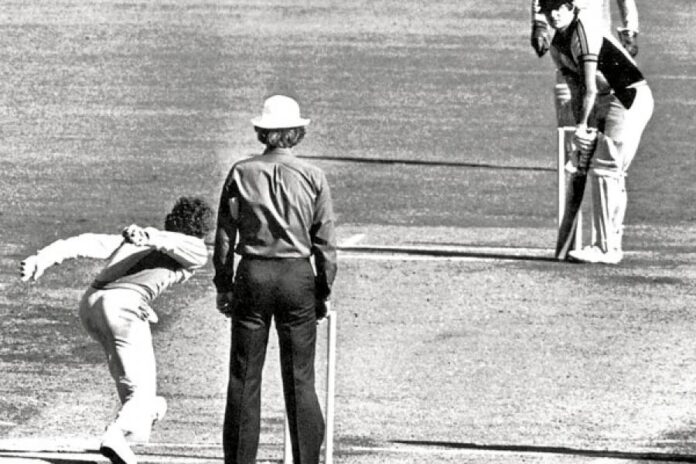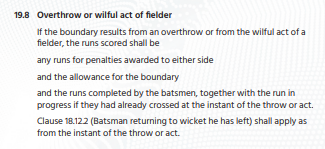Cricket, usually referred to as a gentleman’s game, is known for its complex rules and centuries-old traditions. While the basic principles of the sport are understood by millions of followers worldwide, moving into the rulebook reveals an undiscovered mine of oddities that can confuse even the most devoted followers. These weird rules in cricket, which are often overlooked or rarely used, offer a sense of humour and unpredictability to the game.
The Mankading Controversy

The Mankading rule, named after famous Indian batter Vinoo Mankad, is one of cricket’s most contentious and controversial odd rules. If the non-striker leaves the crease before the ball is bowled, the bowler must run him out. While this regulation intends to prevent batters from gaining an unfair advantage, it often provokes intense arguments over sportsmanship. Some consider it a valid strategy, while others consider it unsportsmanlike behaviour. The Mankading rule shows the very thin line between sportsmanship and fair play in cricket.
The Underarm Delivery Rule

When the ball doesn’t bounce before it reaches the batsman when bowling underarm, the cricketing world as a whole decided that it was unsportsmanlike in 1981. When Australian bowler Trevor Chappell used it to stop New Zealand batsman Brian McKechnie from hitting a six, it became part of history.
The Bizarre Timed-Out Rule

We’ve all heard of batsmen being dismissed in cricket- caught, bowled, LBW, and more. But what about getting out due to tardiness? That’s where the Timed Out rule comes into play. This fairly weird rule states that the incoming batter might be given out if it takes them more than three minutes to get to the crease after the previous batsman is dismissed. Although the regulation is rarely followed, it gives the game a sense of urgency by making it impossible for teams to modify their batting order at their leisure.
The Odd Overthrows

Overthrows can result in extra runs for the batting side when a fielder accidentally deflects the ball away from the stumps. However, the fact that the number of runs granted might occasionally be unpredictable makes this regulation stand out as one of the weird rules in cricket. Even if the batting side didn’t intend to run, they may receive up to six runs if the ball lands on the batsman’s body or equipment and travels to the boundary. This regulation makes the game more chaotic as even a small error might give the batting side a big advantage.
The Boundary Catch Rule

Getting a ball at the boundary is one of cricket’s most exciting experiences. However, the rules for these boundary catches are anything but simple. One of the weird regulations of cricket requires a fielder to release the ball after making a catch with some part of their body in contact with the ground. Whether or not the fielder was in the air while completing the catch, counts as a six if they cross the boundary before releasing the ball. This regulation makes boundary catches more difficult and requires fielders to make precise, acrobatic techniques.
Unusual Stumping Dismissal Rule

The technique of stumping is well-known to cricket fans. If a batter goes too far from the crease while trying to hit a ball, the wicketkeeper will immediately whip off the bails. When the bails are taken off, what happens if the ball is in the air? The batter is still out if they are outside of their crease, according to cricket’s weird rules. It might be confusing for both players and viewers to understand this uncommon dismissal, which frequently happens when a batter loses balance and elevates a foot.
The Handled the Ball Rule

In the game of cricket, players use different areas of their bodies to defend the stumps and score runs. The hand is the one body part that players have to refrain from utilizing when handling the ball. A batsman can be removed if they purposefully contact the ball with their hand. Players must be careful not to let their instincts get the best of them when the ball is going their way owing to the little-used rule known as handling the ball, which gives the game an exciting new dimension.
In addition to the rules mentioned above, there are a few other weird rules in cricket that you may not know about:
- A fielder can be penalized for attempting to confuse the batsman by pretending to catch the ball, which is known as false fielding. This can result in the batting team receiving five penalty runs.
- A match can be forfeited if the fielding team fails to bowl the required number of overs in a day. This is often due to severe weather or other unexpected factors.
- A batter is not out if the ball strikes his helmet and afterwards the stumps, as long as the bails do not fall off. This is because the helmet is not regarded to be a part of the wicket.
- A batter can be given out if he/she hits the ball twice. This is called a double hit and is considered to be unfair to the fielding team.
In the end, cricket’s weird rules are a testament to the sport’s rich history and dedication to preserving a careful balance of tradition and innovation. While some of these rules may appear weird or even bizarre, they contribute to cricket’s distinct appeal, making it a sport that continues to attract fans worldwide.
Read More: Highest Run Scorers In Test Cricket History

